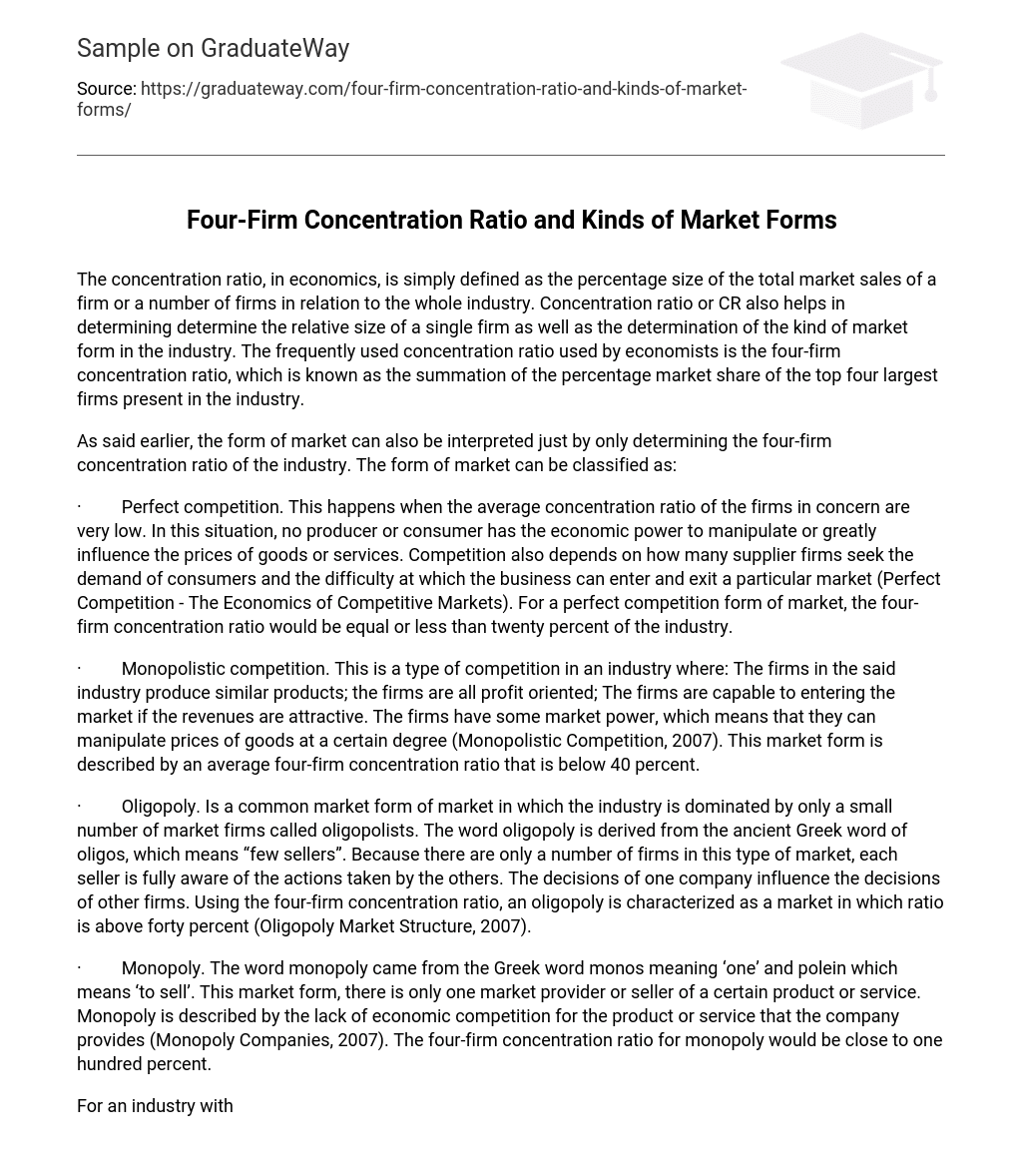The concentration ratio, in economics, is simply defined as the percentage size of the total market sales of a firm or a number of firms in relation to the whole industry. Concentration ratio or CR also helps in determining determine the relative size of a single firm as well as the determination of the kind of market form in the industry. The frequently used concentration ratio used by economists is the four-firm concentration ratio, which is known as the summation of the percentage market share of the top four largest firms present in the industry.
As said earlier, the form of market can also be interpreted just by only determining the four-firm concentration ratio of the industry. The form of market can be classified as:
· Perfect competition. This happens when the average concentration ratio of the firms in concern are very low. In this situation, no producer or consumer has the economic power to manipulate or greatly influence the prices of goods or services. Competition also depends on how many supplier firms seek the demand of consumers and the difficulty at which the business can enter and exit a particular market (Perfect Competition – The Economics of Competitive Markets). For a perfect competition form of market, the four-firm concentration ratio would be equal or less than twenty percent of the industry.
· Monopolistic competition. This is a type of competition in an industry where: The firms in the said industry produce similar products; the firms are all profit oriented; The firms are capable to entering the market if the revenues are attractive. The firms have some market power, which means that they can manipulate prices of goods at a certain degree (Monopolistic Competition, 2007). This market form is described by an average four-firm concentration ratio that is below 40 percent.
· Oligopoly. Is a common market form of market in which the industry is dominated by only a small number of market firms called oligopolists. The word oligopoly is derived from the ancient Greek word of oligos, which means “few sellers”. Because there are only a number of firms in this type of market, each seller is fully aware of the actions taken by the others. The decisions of one company influence the decisions of other firms. Using the four-firm concentration ratio, an oligopoly is characterized as a market in which ratio is above forty percent (Oligopoly Market Structure, 2007).
· Monopoly. The word monopoly came from the Greek word monos meaning ‘one’ and polein which means ‘to sell’. This market form, there is only one market provider or seller of a certain product or service. Monopoly is described by the lack of economic competition for the product or service that the company provides (Monopoly Companies, 2007). The four-firm concentration ratio for monopoly would be close to one hundred percent.
For an industry with 20 firms with a four-firm concentration ratio of 30%, the net CR for the four biggest firms would be: 30 percent divided by 4 firms would be 7.5% each. The average concentration ratio for the remaining 16 firms would be 100% less the 30% of the four-firm CR, over-all divided by 16 firms. That value would be equal to 4.375%. Comparing the average CR for the four biggest firms versus CR of the 16 firms, we would get a difference of 3.125% which is somewhat a small value. This interprets that the said market has a perfect competition or monopolistic in form. This also translates that the four biggest firms have some economic powers that can change the prices of the goods and services. If the demand of the product rises and pushes up the price of the good, the demand for that product or service would definitely go lower, hence the supply increase since firms tend to produce more where there are more profits. Suppose the demand for the product rises and pushes up the price for the good. In the long run, competition between market firms become more intense, leaving a tight business and this eventually will create a somewhat equal revenues within firms and will cause close values of concentration ratio between different firms thus there would be a decrease in the net four-firm concentration ratio.
Now, if we consider the inverse of the first situation, that is, the four-firm concentration ratio would be 80 percent, while the CR for the smaller firms is only 20 percent, the market form would be more like close to monopoly or to be exact, oligopoly. In this situation, each of the firms included in the four-firm concentration ratio would have an average CR of 20 percent, while the smaller companies would have an average concentration ratio of 1.25 percent. As we have discussed earlier, oligopolists have much economic power at their expense that they can manipulate the prices of the goods and services in the industry. This scenario shows that the other small firms have so much little power that they cannot dictate the prices of the products they sell. If they cannot follow the prices that the bigger firms have set, they would earn less profit or sometimes gain no revenues at all. This would cause the smaller firms to become bankrupt and eventually close.
The concentration ratio is a simple yet very useful tool to determine whether the company can exceed or compete with the other firms present in the market. For newly made firms, industries with low four-firm CR is much more desirable to enter than markets with higher four-firm CR values.
References:
Concentration Ratio. (2007). Retrieved September 1, 2007, from Investopedia Website: http://www.investopedia.com/terms/c/concentrationratio.asp
Monopolistic Competition. (2007). Retrieved September 1, 2007, from Investopedia Website: http://www.investopedia.com/terms/m/monopolisticmarket.asp
Monopoly Companies. (2007). Retrieved September 1, 2007, from Basic Economics Website: http://www.basiceconomics.info/monopoly-companies.php
Oligopoly Market Structure. (2007). Retrieved September 1, 2007, from BAsic Economics Structure Website: http://www.basiceconomics.info/oligopoly-market-structure.php
Perfect Competition – The Economics of Competitive Markets. (n.d.). Retrieved Septermber 01, 2007, from Tutor2u website: http://www.tutor2u.net/economics/content/topics/competition/competition.htm





